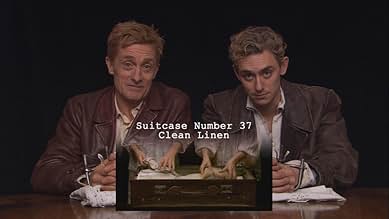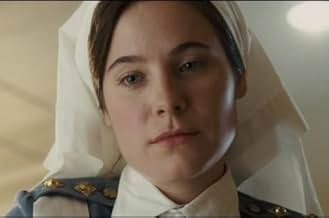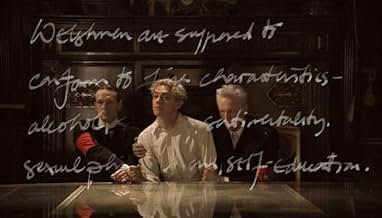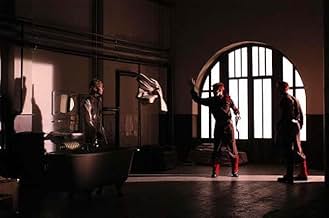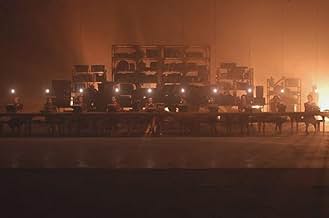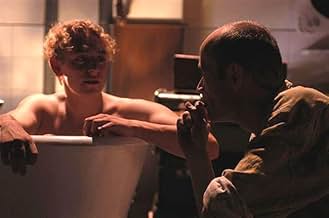Las maletas de Tulse Luper: La historia de Moab
Título original: The Tulse Luper Suitcases, Part 1: The Moab Story
PUNTUACIÓN EN IMDb
6,7/10
1,3 mil
TU PUNTUACIÓN
Tulse Luper de niño durante la Primera Guerra Mundial, como explorador en el Utah mormón y como escritor en Bélgica durante el ascenso del fascismo.Tulse Luper de niño durante la Primera Guerra Mundial, como explorador en el Utah mormón y como escritor en Bélgica durante el ascenso del fascismo.Tulse Luper de niño durante la Primera Guerra Mundial, como explorador en el Utah mormón y como escritor en Bélgica durante el ascenso del fascismo.
- Dirección
- Guión
- Reparto principal
- Premios
- 1 premio y 1 nominación en total
Jordi Mollà
- Jan Palmerion
- (as Jordi Molla)
Nilo Zimmermann
- Pip
- (as Nilo Mur)
Reseñas destacadas
i had read a review of this and the 92 DVDs that are part of the project-and essenetially the project itself rather than the actual film- really interested me. unfortunately only the film is available to see and even though it had a certain spirit it was mostly a struggle to watch. there are some films, where one has to give up on trying to follow a strict narrative or a plot, but rather follow the mood and the visuals and the emotion that the film evokes. "Tulse Luper" seems to be that at the get-go. i was curious and i watched patiently, but the more i watched the more it seemed the technique itself cannot be the most interesting thing going on, especially when the film is only a part 1 and I will have to wait indefinately to see a conclusion. be creative, but be lively and inventive across the border, not just in edit. i think the Pillow Book offered more to the senses and its visual style better served the story.
having said all that i still really badly want to see the project as a whole
having said all that i still really badly want to see the project as a whole
Boy, this is a tricky sonofabitch to evaluate. Tulse Luper is a recurring character in Greenaway's work, kind of a Kilgore Trout to Greenaway's Kurt Vonnegut. And the film makes multiple references to his other works, even citing Luper as their author. And Luper is attributed with having an obsession for categorization and numbering, obsessions inescapably associated with Greenaway's films. But is anything about this truly autobiographical? Is it more akin to Guy Maddin's sense of the poetic autobiography? Or is it just nonsense? Knowing Greenaway, everything in this film is done for very specific (and probably quite complex) reasons. But it's all so elusive and dense with symbolism and double meanings that it's impossible for me to decipher on a single viewing, and I would probably require the use of additional multimedia aids to truly decode it all. Although he hasn't entirely cast aside narrative, it's so shattered by formalist clutter (the literal "frames within frames" as seen in PILLOW BOOK, stylized sets, encyclopedic detail, seemingly pointless use of repetition and contradictory or complementary images) that it's difficult to say "what happens" except in vague terms. As is often the case with Greenaway, it holds almost no emotional resonance (and some of it, especially regarding the Percy character, is kinda stupid). There is no doubt that most would write it off as pretentious drivel. But I found it fascinating nonetheless. It's not the most experimental thing I've ever seen, nor the most unpredictable or surprising. But it's original enough to hold my interest, and it does so with a unique and often beautiful sense of style.
The Moab Story is part 1 of a 3 part, 6 hour film tracing the life of the eponymous Tulse Luper and, for reasons not yet clear, the history of Uranium (atomic number 92 - this is important so pay attention at the back).
Greenaway continues to evolve his directorial style, overlapping images and sounds, embedding windows within windows, mixing media. The results are often confusing, sometimes stunning, never boring.
I wondered if Greenaway was hinting that this was in some sense an autobiographical piece. Tulse Luper is cited as the author of 'The Belly of an Architect' and in a list of his lost works appears 'The Falls', both earlier films by Greenaway.
Of course it might just be the director playing games. A clip from 'A Zed and Two Noughts' is used at one point, and there is a character named 'Cissie Colpits', the name of the three women in 'Drowning by Numbers'. I suspect there might well have been many more references to earlier films in there.
This is closer in style to 'Properos Books' or 'A TV Dante' than some of his earlier works such as 'The Cook, the Thief, his Wife and her Lover'. Narrative flow has been sacrificed in part for creating a cinematic work of art. Nothing wrong with that in my opinion though, when the result is a film like this. Sit back and let the experience wash over you.
Greenaway continues to evolve his directorial style, overlapping images and sounds, embedding windows within windows, mixing media. The results are often confusing, sometimes stunning, never boring.
I wondered if Greenaway was hinting that this was in some sense an autobiographical piece. Tulse Luper is cited as the author of 'The Belly of an Architect' and in a list of his lost works appears 'The Falls', both earlier films by Greenaway.
Of course it might just be the director playing games. A clip from 'A Zed and Two Noughts' is used at one point, and there is a character named 'Cissie Colpits', the name of the three women in 'Drowning by Numbers'. I suspect there might well have been many more references to earlier films in there.
This is closer in style to 'Properos Books' or 'A TV Dante' than some of his earlier works such as 'The Cook, the Thief, his Wife and her Lover'. Narrative flow has been sacrificed in part for creating a cinematic work of art. Nothing wrong with that in my opinion though, when the result is a film like this. Sit back and let the experience wash over you.
This film is the nth Wonder of the World. It's just so unashamedly full of details, pictures in pictures, special effects, not so special effects, special and unspecial characters, kids, lists of lists, colors, sets, music that puts other, more franchise-y trilogies such as Matrix and Lord of the Rings to shame, plot, plot, plot, perspectives and fiery dialogue about America, Europe, war, sex, friendship, family, torture, dentistry,... It's nominally about stuff like imprisonment and 20th century history, but it's really all about the limits of film and the artist's ability to satirize his own extremism. And the tracking-shots are just stupid, in a good way. And it's completely insane. And so funny I was shaking and bit my chewing gum in half. It never stops. I think P.G. ran out of money --- the sequel wasn't too great --- which is a shame, he's been planning this for years. Anyway, I believe I enjoyed this film. And hey: I love Ferris Bueller's Day Off and Braveheart too.
I have three living filmmakers that I revere. Greenaway, of course, is one of them and the most obstreperous of the bunch. I like that he has real problems with making illustrated books and does something substantial out of that.
His fundamental notions of the world are built on overlapping conceptual frameworks, ordered frameworks. In this, he follows the Joycean tradition of "Finnegans Wake," which layered all sorts of frameworks from Kabbalistic, Vican, mythological, even geographic sources. It was all merged according to a dream logic since we had no other template in that day and used every lexical and literary device he could muster.
Where Joyce had to make do with dream-layering, our Peter gets to use already familiar web- referenced multimedia overlays. He surely knows how to use the software to extend the art of editing into new dimensions. Wow, just on that score.
And where Joyce used obtuse frameworks with the intent of his book being a life's reading, Greenaway uses obvious overlapping frameworks: numbers, his own life and the mythology from his prior films. Some categories, like the periodic table. Oddly, he hasn't been as thorough in this film as he has in some others: Vermeer's theories of light, animals, sexual stereotypes, the written word, various frameworks of introspection and reflection. Different slices on gender.
Anyway, the point is that where Joyce was esoteric, Greenaway strives to be obvious, though manylayered, even juvenile, in his frameworks. He wants these to be so simple and grand that he can stretch them to many web sites, films, CDs, games, and (I presume) books and installations. Someone can casually enter a part of the larger work and intuit the order of the thing.
Each fan of Greenaway will have to make her own decisions on what she likes in terms of the different balances he has struck. As for me, I want a tighter integration of framework and image than he has here. This is why I value his "book" films the highest.
What does this add to what we have? Sadly, not much, except an attempt to integrate himself and some of the political sweeps of the ordinary world, which he tags to nuclear control. I've often thought that the artists themselves are dumber than the art they produce and the greater distance we have from their personalities, the better.
If you have talked to Greenaway, you'll see this in a flash. He has some good headlines, having to do with the bankruptcy of narrative in film. But beyond that, his films (some of them) soar, while his own spoken narrative crawls.
Ted's Evaluation -- 3 of 3: Worth watching.
His fundamental notions of the world are built on overlapping conceptual frameworks, ordered frameworks. In this, he follows the Joycean tradition of "Finnegans Wake," which layered all sorts of frameworks from Kabbalistic, Vican, mythological, even geographic sources. It was all merged according to a dream logic since we had no other template in that day and used every lexical and literary device he could muster.
Where Joyce had to make do with dream-layering, our Peter gets to use already familiar web- referenced multimedia overlays. He surely knows how to use the software to extend the art of editing into new dimensions. Wow, just on that score.
And where Joyce used obtuse frameworks with the intent of his book being a life's reading, Greenaway uses obvious overlapping frameworks: numbers, his own life and the mythology from his prior films. Some categories, like the periodic table. Oddly, he hasn't been as thorough in this film as he has in some others: Vermeer's theories of light, animals, sexual stereotypes, the written word, various frameworks of introspection and reflection. Different slices on gender.
Anyway, the point is that where Joyce was esoteric, Greenaway strives to be obvious, though manylayered, even juvenile, in his frameworks. He wants these to be so simple and grand that he can stretch them to many web sites, films, CDs, games, and (I presume) books and installations. Someone can casually enter a part of the larger work and intuit the order of the thing.
Each fan of Greenaway will have to make her own decisions on what she likes in terms of the different balances he has struck. As for me, I want a tighter integration of framework and image than he has here. This is why I value his "book" films the highest.
What does this add to what we have? Sadly, not much, except an attempt to integrate himself and some of the political sweeps of the ordinary world, which he tags to nuclear control. I've often thought that the artists themselves are dumber than the art they produce and the greater distance we have from their personalities, the better.
If you have talked to Greenaway, you'll see this in a flash. He has some good headlines, having to do with the bankruptcy of narrative in film. But beyond that, his films (some of them) soar, while his own spoken narrative crawls.
Ted's Evaluation -- 3 of 3: Worth watching.
¿Sabías que...?
- Curiosidades'Cissie Colpitts' is the name shared by the three main female characters in Conspiración de mujeres (1988), by the same director.
- ConexionesEdited into The Tulse Luper Suitcases: Antwerp (2003)
Selecciones populares
Inicia sesión para calificar y añadir a tu lista para recibir recomendaciones personalizadas
- How long is The Tulse Luper Suitcases, Part 1: The Moab Story?Con tecnología de Alexa
Detalles
- Fecha de lanzamiento
- Países de origen
- Sitio oficial
- Idiomas
- Títulos en diferentes países
- Les maletes de Tulse Luper: La història de Moab
- Localizaciones del rodaje
- Empresas productoras
- Ver más compañías en los créditos en IMDbPro
Taquilla
- Presupuesto
- 10.000.000 US$ (estimación)
- Recaudación en todo el mundo
- 90.071 US$
- Duración
- 2h 7min(127 min)
- Color
- Mezcla de sonido
- Relación de aspecto
- 1.85 : 1
Contribuir a esta página
Sugerir un cambio o añadir el contenido que falta

